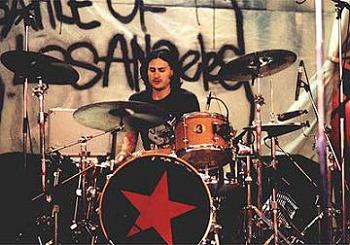
 : : Great drummers
: : Great drummers
- Acuña Alex
- Agostini Dante
- Alexander Tim "Herb"
- Allen Tony
- Ameen Robby
- Appice Carmine
- Aronoff Kenny
- Arpino Thierry
- Barretto Ray
- Belleville Pierre
- Bellson Louie
- Bissonette Gregg
- Blackwell Ed
- Blaine Hal
- Blakey Art
- Bonham John
- Bozzio Terry
- Brown Carlinhos
- Brown Gerry
- Bruford Bill
- Carrington Terri Lyne
- Ceccarelli André
- Cerrone Marc
- Chambers Dennis
- Cinelu Mino
- Clarke Kenny
- Cobham Billy
- Colaiuta Vinnie
- Collins Phil
- Conte Luis
- Copeland Stewart
- Da Fonseca Duduka
- de Grasso Jimmy
- de Johnette Jack
- Diabaté Inza
- Diaz Miguel "Anga"
- Dodds Warren "Baby"
- Donati Virgil
- Dunbar Lowell “Sly”
- Erbetta Marc
- Erskine Peter
- Escovedo Sheila "E"
- Ewandé Louis César
- Fanfant Jean-Philippe
- Foster Al
- Gadd Steve
- Garibaldi David
- Gastaldin Claude
- Gonzalez Jerry
- Gozzo Alain
- Greer Sonny
- Grohl Dave
- Guem
- Gurtu Trilok
- Gustke Ralf
- Hakim Omar
- Haynes Roy
- Hernandez “El Negro” Horacio
- Hidalgo Giovanni
- Higgins Billy
- Hoglan Gene
- Humair Daniel
- Hussain Zakir
- Jacquin Jean-Christophe
- Jimbo Akira
- Jones Elvin
- Jones "Philly" Joe
- Jones « Papa » Jo
- Jordison Joey
- Katché Manu
- Keita Mamady
- Kolinka Richard
- Krupa Gene
- Lake JR Oliver Gene
- Lang Thomas
- Latham Rick
- Mac Brain Nicko
- Mason Harvey
- Mattalia Alessia
- Mayer Jojo
- Michelino Silvano
- Minnemann Marco
- Mitchell John "Mitch"
- Mocidade Independente de Padre Miguel
- Moeller Sanford
- Moreira Airto
- Morello Joe
- N'Diaye Rose Doudou
- Oxley Tony
- Paice Ian
- Paolini Jean-Claude
- Parker Leon
- Peart Neil
- Phillips Simon
- Poleo Orlando
- Porcaro Jeff
- Portnoy Mike
- Pozo Chano
- Priester Aquiles
- Puente Ernesto « Tito »
- Purdie Bernard "Pretty"
- Quintana Jose Luis "Changuito"
- Rekow Raul
- Renaudin Bertrand
- Rich Buddy
- Roach Max
- Roddy Derek
- Samba Mokhtar
- Sanchez Poncho
- Santamaria Mongo
- Séry Paco
- Smith Chad
- Smith Marvin “Smitty”
- Smith Steve
- Sorum Matt
- Starr Ringo
- Stewart Bill
- Stubblefield Clyde
- Temiz Okay
- Terrana Mike
- Top Secret Drum Corps Basel Suisse
- Ulrich Lars
- Vander Christian
- Wassy Brice
- Watts Charlie
- Watts Jeff
- Webb Chick
- Weckl Dave
- White Lenny
- Wilk Brad
- Williams Tony
- Ziad Karim
Wilk Brad
Musicians or bands:
Rage Against The Machine, Audioslave, Chris Cornell, Tim Commerford, Tom Morello
Biography and commentary:

Tony Williams (1945-1997), operated the transition between bebop and fusion, by joining the Miles Davis quintet in 1962 (replacing "Philly" Joe Jones), at 17 years old (he already took part in jam sessions at 15) which evidences an exceptional precociousness. Miles Davis said he had to get back to work his instrument because of him. He is one of the first masters of improvisation with the four limbs, of the three limbs roll and the playing with strokes alternating (wrist-finger, especially for a devastating fast bop chabada with one handed roll). Tony turned to a more funky and Latin playing (binary, already present in the "fast bop") since the first "fusion" albums of Miles Davis (first funky piece: "Stuff" album "Miles in the Sky ", 1968). You should know that from the beginning, Tony was a fan of Ringo Starr, who influenced his playing, even in a bebop context (subtle swing, rim shots, ghost notes, violent breaks in single stroke rolls, flams, alternated with bass drum, etc.). The influence of the Jimi Hendrix Experience (with Mitch Mitchell on drumset, 1967) for this "jazz rock" orientation was surely decisive as evidenced by interviews with Miles Davis and his desire aborted by the untimely death of Jimi, to play with him. As Elvin Jones or John Bonham at the same time (1960, 1970), Tony marks a turning point in the approach to drumset, which reached levels of melodic and polyrhythmic complexity, and playing speeds, almost unsurpassable and on an altogether different scale from what was made before them (except perhaps by Buddy Rich, who also initiated the "jazz and rock” mixing on drumset with" Swingin' New Big Band" in 1966, with the cover of a Stevie Wonder hit of the same year: "Up-Tight").
Marc De Douvan, publication in French: October 10, 2008 (for the translation in English: July 12, 2015)
Official website
SeeLink to Drummerworld or other
See© 2005 Marc de Douvan Crédits Mentions légales
